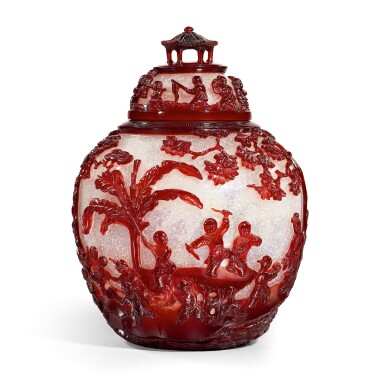Important Chinese Art
Important Chinese Art

Property from a Distinguished Private Collection 傑出私人收藏
An extremely rare and superb ruby-red overlay Peking glass jar and cover Seal mark and period of Qianlong | 清乾隆 雪霏地套寶石紅料庭園仕女嬰戲圖蓋罐 《乾隆年製》款
Auction Closed
April 22, 07:57 AM GMT
Estimate
3,000,000 - 4,000,000 HKD
Lot Details
Description
Property from a Distinguished Private Collection
An extremely rare and superb ruby-red overlay Peking glass jar and cover
Seal mark and period of Qianlong
傑出私人收藏
清乾隆 雪霏地套寶石紅料庭園仕女嬰戲圖蓋罐 《乾隆年製》款
of ovoid shape, the deep red overlay skilfully carved in relief and undercut through to the translucent snowflake ground with numerous boys running playfully over a bridge, around a pavillion and along the rocky bank of a river under the shelter of pine, plantain and maple trees with two ladies in attendance, the children grasping weapons, flying flags and beating drums, all under a wheel-cut keyfret band at the rim, the domed cover encircled by further animated boys and surmounted by a pierced pavilion-shaped knop, the recessed base carved in relief with a red four-character seal mark
overall 19 cm
Collection of Harris Hammond, Bordentown, New Jersey.
Collection of Allen J. Mercher, Great Neck, Long Island.
Sotheby's New York, 9th October 1957, lot 42.
Collection of Walter F. Smith Jr., of Trenton, New Jersey.
Sotheby's London, 19th March 1968, lot 29.
Collection of W. Henrich.
Collection of Mrs T. and Professor Peter Hariolf Plesch.
Sotheby's Hong Kong, 2nd May 1995, lot 202.
Harris Hammond 收藏,新澤西州 Bordentown
Allen J. Mercher 收藏,紐約長島大頸
紐約蘇富比1957年10月9日,編號42
Walter F. Smith Jr. 收藏,新澤西州 Trenton
倫敦蘇富比1968年3月19日,編號29
W. Henrich 收藏
Peter Hariolf Plesch 教授伉儷收藏
香港蘇富比1995年5月2日,編號202
Peter Hariolf Plesch, 'Some Approaches to the Study of Later Chinese Glass', Festschrift für Professor P.W. Meister, Hamburg, 1975, p. 77, fig. 14.
Peter Hariolf Plesch, 'Some Decorative Techniques Found in Later Chinese Glass', Transactions of the Oriental Ceramic Society, vol. 44, 1979-80, pls 7a-c.
Sotheby's Thirty Years in Hong Kong: 1973-2003, Hong Kong, 2003, pl. 444.
Peter Hariolf Plesch,〈Some Approaches to the Study of Later Chinese Glass〉,《Festschrift für Professor P.W. Meister》,漢堡,1975年,頁77,圖14
Peter Hariolf Plesch,〈Some Decorative Techniques Found in Later Chinese Glass〉,《東方陶瓷學會彙刊》,卷44,1979-80年,圖版7a-c
《香港蘇富比三十週年》,香港,2003年,圖版444
Professor Peter Hariolf Plesch in 'Some Decorative Techniques Found in Later Chinese Glass', op.cit., p. 48, notes on the present piece that "Chinese glass was carved by craftsmen who were by training, or at least by tradition lapidaries. Following that tradition, the best of them sought to give the decoration a three-dimensional quality which characterises the work of the best jade carvers". He further mentions ibid., pp. 53-55, that "the composition and execution of the design, the attention to detail, and the meticulous after - polishing of all the surfaces on this 'Playing Boys Jar' set a standard which is attained only by few pieces of similar size known to us, and is rare even in snuff bottles". The pavillion forming the knop of the cover was also laboriously cut from a solid layer of thick red glass and is a fine example of the very high level of workmanship achieved by this time.
Glasswares of this exceptional quality and craftsmanship were produced in the Glass House in the Forbidden City. The glass workshop was established in 1696 under the jurisdiction of the Zaobanchu. It was supervised by Kilian Stumpf, a Jesuit missionary with the scientific skills of glassmaking. Kilian is said to have introduced the art of glassmaking to the court and was in charge of hiring two other French Jesuit glass craftsmen, known as Vilatte and d'Andigne, along with a few talented Chinese artisans from Yanshen and Guangzhou to work in the Glass House. By Qianlong's reign glassmaking reached its zenith, especially with the help of further two Jesuit missionaries Gabriel-Leonard de Brossard and Pierre d'Incarville who introduced new designs and successfully produced glass types not seen before. The Qianlong Emperor was particular about glasswares produced in the Glass House and palace records show that "when the emperor was pleased with their standard of workmanship, he learned the names of the various officials responsible for the wares, and ordered them to be rewarded with generous amounts of silver. However, if he was irritated by the poor quality of the glassware, he would impose a series of penalties including the reduction of wages, and make the glassworks bear all the manufacturing costs." (Emily B. Curtis, 'Qing Glassmaking. The Jesuit Workshop on Canchikou', Luster of Autumn Water, Beijing, 2004, p. 98).
See a closely related Qianlong mark and period ruby-red overlay jar and cover, of slightly bigger size, but similarly carved in relief and undercut through to the translucent snowflake ground with boys playing around a pavillion and ladies in attendance, also with a pierced pavilion-shaped knop, sold in our London rooms, 20th June 2001, lot 111. Compare also a pair of bottle vases, carved through the red overlay on snowflake ground with the immortals in various pursuit against the background of rocks and pine trees, included in the exhibition Elegance and Radiance, The Art Museum, The Chinese University of Hong Kong, Hong Kong, 2000, cat. no. 111.
It is also unusual to find such a finely written seal mark on the base, precisely cut through the overlay rather than wheel-engraved. One jar with a Qianlong mark of this type was sold in these rooms, 12th May 1983, lot 277, and again in our London rooms, 17th November 1999, lot 788.
普萊氏教授在1979-80年倫敦東方陶瓷學會刊發表的〈Some Decorative Techniques Found in Later Chinese Glass [中國晚期玻璃器中的裝飾技術]〉一文中提及此器,頁48:中國玻璃器由經驗豐富的能工巧匠雕琢而成,秉承傳統,所雕琢之紋飾如精緻的玉器,賦予立體質感;頁53-55:此罐的設計、構圖、工藝、細節點綴至拋光打磨於方寸之間,所見他例寥寥無幾,即使在鼻煙壺中也少見。精緻的亭臺式蓋鈕,層次分明生動,展示了當時高超的藝術水平,堪為鬼斧神工。
玻璃器在明清時期稱為「料器」,如此罐般精雕細琢的料器出於造辦處玻璃廠。康熙三十五年,皇帝邀請德國傳教士兼技師紀理安作技術指導,建立了清宮玻璃廠。玻璃廠內能工巧匠雲集,主要來自山東博山及廣州等地,與來自歐洲的匠師如格林、紀文、湯執中等,憑藉中西文化智慧之精髓及高超技藝,燒煉出色彩豐富、精緻純淨的玻璃器。時至乾隆玻璃製造技術達到了頂峰,前無古人,後無來者。
乾隆對玻璃廠的生產特別關注,庫爾提斯〈耶穌會士與清朝的玻璃製造〉(錄於張榮《光凝秋水》,北京,2004年,頁88)載:「許多記載顯示,當時的玻璃工匠們非常害怕處罰。根據故宮的檔案記載,當皇帝對他們的手藝水平滿意的時候,皇帝就打聽有關負責的官員姓名,然後就慷慨的賞賜他們白銀;但是,如果劣質的玻璃器皿惹惱了皇帝,皇帝就會作出一系列處罰,包括扣減工資,賠償所有的成本。」
一例與本器非常接近,尺寸稍大,帶乾隆款雪霏地套寶石紅料蓋罐,同飾仕女嬰戲,亭臺蓋鈕,售倫敦蘇富比2001年6月20日,編號111。雪霏地套寶石紅料瓶,飾松下仙人,展於《虹影瑤輝:李景勳藏清代玻璃》,香港中文大學文物館,香港,2000年,編號111。
此罐底部落款精細獨特,施套料工藝而非直接刻於器底。一例售於香港蘇富比1983年5月12日,編號277,後再售於倫敦蘇富比1999年11月17日,編號788。
